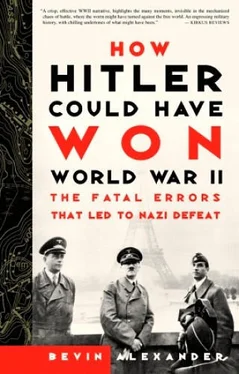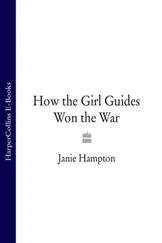Graziani had 80,000 men at the front but only 120 tanks. The Italian infantry had little motor transport and were vulnerable to being surrounded by mobile British columns in the open desert country, where military formations could find little or no cover. Also, the Italian tanks were fourteen-ton M13 models with moderate armor and a low-power 47-millimeter gun. They were not wholly inadequate for the period but they had a bad reputation. Soldiers on both sides referred to them as “self-propelled coffins.” The British on the other hand had fifty heavily armored Matildas impervious to most Italian guns. These played a decisive role in the battles that followed.
O’Connor decided to approach the Italian camps from the rear, since the Italians had mined the spaces in front. On the night of December 8, the British passed through a gap in the enemy’s chain of camps, and early on December 9 stormed Nibeiwa camp from behind, with Matildas leading the way. The garrison, surprised, ran off, leaving 4,000 prisoners. Early in the afternoon the Matildas stormed two other camps to the north, Tummar West and Tummar East, sending these garrisons flying as well. Meanwhile the 7th Armored Division, soon to gain fame as the “Desert Rats,” drove westward, reached the coast road, and got astride the Italians’ line of retreat.
The next day the 4th Indian Division, aided by two tank regiments sent back by 7th Armored, moved north, converged on both sides of camps clustered around Sidi Barrani, and overran the position, taking thousands of prisoners.
On the third day, the reserve brigade of 7th Armored bounded westward twenty-five miles to the coast beyond Buq-Buq, where it intercepted a large column of retreating Italians, and captured 14,000. Within three days, half the Italians in Egypt had surrendered.
The remainder of the Italian army took refuge in the coast fortress of Bardia, just inside the Libyan frontier. The 7th Armored swiftly isolated Bardia by sweeping around to the west. It took until January 3, 1941, to bring up infantry to assault Bardia with twenty-two Matildas leading the way. The whole Italian garrison gave up: 45,000 men and 129 tanks.
The 7th Armored Division immediately rushed west to isolate Tobruk. When Australian infantry attacked on January 21 behind the sixteen Matildas still working, 30,000 Italians surrendered with eighty-seven tanks.
The Italians were offering practically no resistance, and at the rate they were going the British could have continued on to Tripoli. Unfortunately, Churchill decided to hold back British reserves to take advantage of another blunder that Benito Mussolini had made—on October 28 he had invaded Greece from Albania, which he had occupied in 1939. It was an act of strategic lunacy, for it involved Italy in a two-front war when it was having almost insuperable difficulties maintaining a one-front operation in North Africa. Il Duce (the leader), as Mussolini was called, hoped to carve out an Italian empire, but the Greeks resisted fiercely, drove the Italians back into Albania, and were threatening to rout the whole Italian army.
Hitler only learned about the attack after meeting with Mussolini in Florence the day it started. He was furious, because it disrupted all his plans, even his hesitant thinking about sending troops to North Africa.
Hitler had just come from meetings with the Spanish dictator Franco on the French border at Hendaye on October 23, and Pétain the next day at Montoire.
The talks at Hendaye went on for nine hours with no commitment on Franco’s part to enter the war and allow German troops to assault Gibraltar. Hitler departed frustrated and angry, calling Franco a “Jesuit swine.” The meeting with Pétain went better. Pétain agreed to collaborate with Germany to bring Britain to its knees. In return, France would get a high place in the “New Europe” and compensation in Africa for whatever territory France was forced to cede to others.
Churchill pushed the Greeks to accept a British force of tanks and artillery, but General Ioannis Metaxas, head of the Greek government, declined, saying the British would provoke German intervention but would be too weak to stop it. Even so, Churchill held forces in Egypt and ordered Wavell not to give O’Connor any reinforcements.
O’Connor meanwhile pushed on westward. His 7th Armored Division had shrunk to only fifty cruiser tanks. On February 3 he learned from air reconnaissance that the Italians were about to abandon the entire Benghazi corner of northwestern Cyrenaica. O’Connor at once ordered the 7th Armored to move through the desert interior to reach the coast road, Via Balbia, well to the south of Benghazi. Rough going through heavy sand slowed the tanks, and on February 4, Major General Sir Michael Creagh, commanding the division, organized an entirely wheeled force of infantry and artillery and sent it ahead with a group of armored cars. By the afternoon of February 5, this force had set up a barrage or barrier across the enemy’s line of retreat south of Beda Fomm. That evening the division’s twenty-nine still-serviceable cruiser tanks arrived and took up concealed positions.
When the main Italian force came up, it was accompanied by a hundred new cruiser M13 tanks that, combined, could have blasted the British out of the way and opened a clear path to Tripoli. But they approached in packets, not massed. The British tanks overpowered each group as it arrived. By nightfall February 6, sixty Italian tanks had been crippled and forty abandoned. With no armor to protect them, the Italian infantry surrendered—20,000 men. The total British force was only 3,000 men. It was one of the most overwhelming victories in the war, and raised British morale immensely.
There were few Italian troops left in Libya, and O’Connor confidently expected to rush on to Tripoli, where Italian officers were packing their bags for a hasty departure.
On February 6, 1941, the day the last Italian elements were being wiped out at Beda Fomm, Adolf Hitler summoned Erwin Rommel, forty-nine years old, to take command of a German mechanized corps that he had finally decided to send to rescue the Italians. The force was not the four panzer divisions General von Thoma had calculated was needed to seize Suez and conquer the Middle East. Rather it consisted of the single panzer division Hitler said he could spare (the 15th), plus a small tank-equipped motorized division (5th Light).
He had selected Rommel because, next to Heinz Guderian, he was the most famous panzer leader in Germany. Rommel’s 7th Panzer Division had moved so fast and mysteriously in May and June that the French called it the “ghost division.” Rommel’s high visibility made him the ideal choice for Africa, since Hitler was seeking primarily a public relations gesture to support Mussolini, not so much to reach a decision in Africa.
The first elements of Rommel’s new Deutsches Afrika Korps (DAK), or German Africa Corps, began arriving in mid-February 1941, though the whole 5th Light Division couldn’t get to Libya until mid-April, and the 15th Panzer Division would not get there till the end of May. There was still plenty of time, therefore, for the British to push on against minuscule opposition to Tripoli, and evict Italy from North Africa.
Just at that moment Prime Minister Churchill pulled up the reins on Wavell and O’Connor. He directed Wavell to prepare the largest possible force for Greece. This ended the advance on Tripoli. The radical change had occurred after General Metaxas died unexpectedly on January 29, and the new Greek prime minister succumbed to Churchill’s urgings to invite the British in.
Churchill foolishly hoped he could build a coalition of Balkan nations against Germany. The Greeks had thrown back the ill-equipped and unenthusiastic Italians, but the primitive Balkan armies were no match for German panzers. And, with the commitment of British forces to the Continent only months before he planned to attack the Soviet Union, Hitler saw his entire position threatened, particularly since British aircraft in Greece could strike at the Romanian oil fields at Ploesti. Hitler depended upon these for his war machine.
Читать дальше


![Джонатан Димблби - Barbarossa - How Hitler Lost the War [calibre]](/books/385421/dzhonatan-dimblbi-barbarossa-how-hitler-lost-the-w-thumb.webp)









